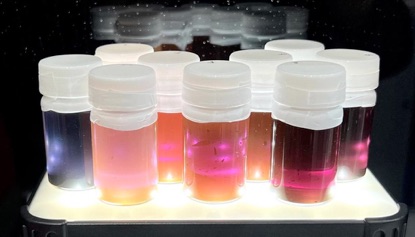Materials ancient and novel: gold nanoparticles
Gold and silver precious metals delight with their fascinatingly beautiful brilliance.
The metal gold is "golden," but in its fine particle state, which is smaller than the wavelength of light, it shows beautiful colors like stained glass. In addition to their traditional use as a coloring material, gold nanoparticles are expected to find a wide range of applications in catalysts, solar cells, biosensors, nanomedicines, optical cloaking, and other areas according to the latest researches.
Photonic Technology of the 21st Century: Plasmon Resonance
When light strikes gold, the free electrons, which are charged particles in gold, are subjected to a periodically fluctuating electric field because light is an electromagnetic wave. The electric charges in the electric field are then set in motion. The periodic fluctuations of the electric field cause the motion of the electrons to oscillate. This is called surface plasmon, which is a collective oscillation of free electrons in gold. Depending on the nature of the metal and the surrounding dielectric constant, the electric field oscillations of the light and the oscillations of the electrons resonate. When this happens, light penetrates the metal and is absorbed. When the electric field of light and the vibration of electrons produce opposite electric fields, the light field is blocked and light cannot penetrate and is reflected. Thus, the interaction between light and metal changes depending on the wavelength. In gold and copper, we can enjoy the beautiful metallic luster of gold and copper because the wavelengths absorbed by the metals are in the visible region.
Invisible Light in Gold Nanoparticles: Localized Plasmon Resonance
This effect is even more dramatic in gold nanoparticles that are smaller than the wavelength of light. Surface plasmons localized on the nanoparticles (localized plasmons) strongly interact with light by resonance, in which electron motion is maximized at specific wavelengths. This is called localized plasmon resonance. In this case, electrons collectively oscillate as if they were overlapping with gold nanoparticles. Since the oscillating electrons also affect the electromagnetic field, the localized plasmon can be thought of as a kind of nano light clinging to the nanoparticles. The gold nanoparticles act like an antenna or lens that collects and concentrates the light. Localized plasmon resonance is even more dramatic when gold nanoparticles are assembled rather than alone. Therefore, it is important to have a technique to assemble gold nanoparticles and control their aggregation and dispersion. We have the proprietary technology.

Gold nanoparticles
We are developing near-future technologies that enable anti-counterfeiting, distribution management (traceability), and dose management by applying a special liquid with gold nanoparticles directly to products.
Labels and tags are used for logistics and distribution management. However, conventional labels and tags have the problem of being removed, misused, and imitated. To solve this problem, we have developed a plasmonic nano tag that can be secretly tagged without being visible on the product itself.
This tag can be used to determine the authenticity of a product without damaging its appearance, and it cannot be peeled off, misused, or imitated.
An era with Stealth tags


for more information



Head Office
8E09, 8F ASTEM bldg.
134 Chudojiminami-machi, Nakagyo-ku
Kyoto City
Lab
Rm. 303, Creation Core Kyoto Mikuruma,
448-5 Kajii-cho, Kamigyo-ku
Kyoto City
©2024,2025 Archilys
Menu
top
お知らせ
Products/Services
R&D
About Archilys








